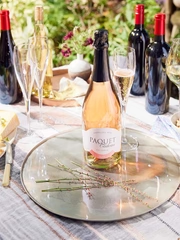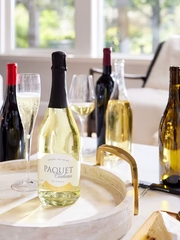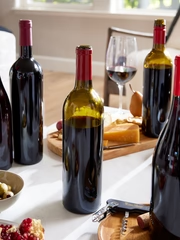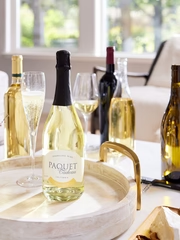Jessica Zamora posted on October 17th:
“I've been wondering why the red bottles vary in shape? I've had customers notice it as well and would love to be able to respond intelligently.”
Sandy Irving wrote on October 23rd:
"Serving the Pinot Grigio this weekend. Everyone who has tried it, give me your impression. How much sweetness? Sweet or Crisp. Flavors, delicate? The color is very golden. Alexandre Reble, why is that?
Kelly Hintzen was enjoying the new JOY labels on October 8th:
“Wines are available for sale!! Isn't this label GORGEOUS?!”
These recent messages posted on our social media platforms gave me the idea to cover in more detail the domain of wine bottle packaging. We receive a lot of posts, tweets and comments related to the work being done months prior to bottling, which is akin to harmoniously assembling numerous puzzle pieces. I’d like to take the time to answer some of these questions. This month will go deeper in the world of closures. Next month we will explore glass bottles and labels.
As wine lovers, we’ve all certainly experienced a “corked” wine. Corked is the term for a wine that has become contaminated by cork taint, which is a set of unpleasant or strange smells and tastes caused by the presence of the chemical trichloroanisole (TCA). The emergence of many types of alternatives closures is due to this fear of cork taint. There have been many studies around this topic in the wine industry. In 2005, Wine Spectator found up to 7% of tainted wines during their blind tastings conducted in Napa. The cork industry claims that this number is actually closer to 1.4%. WineShop At Home currently uses three types of wine bottle closures: the screw cap, the natural cork and the technical agglomerated cork, also called 1+1.
The Screw Cap:
The screw cap provides a more economical closure for a wine bottle compared to the added cost of a cork plus and capsule combination.

Threaded around the bottleneck, the
Seranexgasket, inside the cap itself, is protecting the wine from excess contact with oxygen. In many cases, this gasket prolongs the freshness of the wine’s aromatics. Studies of the oxygen transmission rate have lead winemakers to believe that a wine using a screw cap will taste very similar to the day it was bottled. First results are encouraging after more than 10 years. But technology is moving fast and new products come to life every day with a better seal capability and better breathable material. This closure is usually reserved for wines designed to be consumed fairly rapidly. However, some high end producers that sell their wines at $200 per bottle take the screw cap approach to protect their customer’s investment.
 The Natural Cork:
The Natural Cork:
There is currently about 5.5 million acres of cork forest. Portugal and Spain dominate annual world production with 80% of the market. A mature cork oak tree, which lives for more than three centuries, is harvested every 9 years by stripping the bark from the trunk. The cork industry is regarded as environmentally friendly and sustainable due to the fact that the cork tree is not cut down to obtain cork. Carbon footprint studies concluded that cork is the most environmentally friendly wine stopper in comparison to other alternatives. Using cork as a material has been in practice since the mid-17th century. Sixty percent of wine bottles produced each year use a cork.
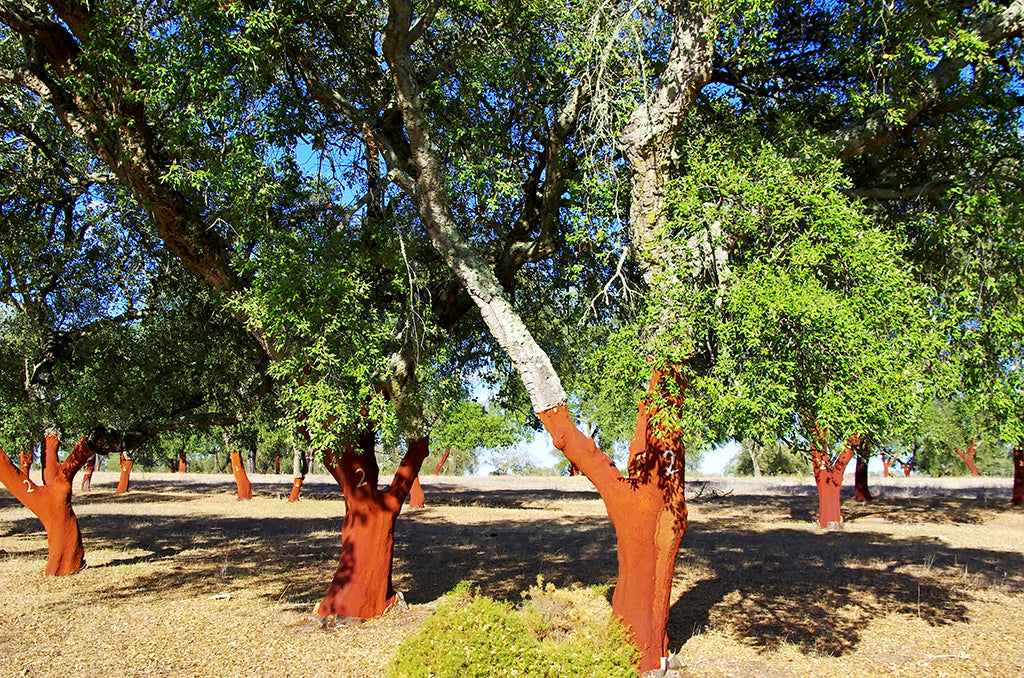
 The Technical Cork:
The Technical Cork:
Some cork planks are too thick to have natural corks punched from them. These are used to make either Champagne corks or technical corks. This type of cork has two parts: a cylinder of agglomerate cork and a disc of natural cork at each end. The agglomerate portion of the cork is made up of what would otherwise be waste cork, ground up into 5-8 mm granules. These granules are then cleaned using a steam process, which removes about 80% of any TCA present. The granules are combined with polyurethane food-grade glue in an extrusion process to make rods of cork. This closure is very reliable and safe, and is chosen by WineShop At Home often because it meets the majority of our needs at bottling.


One noted difference between the technical cork and the screw cap is that over time a microscopic amount of oxygen is released into the wine. This means that the wine will age differently than if it was in a screw cap closure.
The Capsules:
Capsules are a sleeve design to cover the finish of the bottle and the cork.

Polylaminate or Plolylaminate-Tin capsules vary in thickness from 65 to 135 microns and from 30 mm to 70 mm in length. These numbers are all important for printing abilities, wrinkle prevention and resistance to friction during application. There are an abundance of colors available from our suppliers to complement the overall design of the wine and the label.
Stay tuned next month for an in depth view of glass bottles and labels….
 Threaded around the bottleneck, the Seranexgasket, inside the cap itself, is protecting the wine from excess contact with oxygen. In many cases, this gasket prolongs the freshness of the wine’s aromatics. Studies of the oxygen transmission rate have lead winemakers to believe that a wine using a screw cap will taste very similar to the day it was bottled. First results are encouraging after more than 10 years. But technology is moving fast and new products come to life every day with a better seal capability and better breathable material. This closure is usually reserved for wines designed to be consumed fairly rapidly. However, some high end producers that sell their wines at $200 per bottle take the screw cap approach to protect their customer’s investment.
Threaded around the bottleneck, the Seranexgasket, inside the cap itself, is protecting the wine from excess contact with oxygen. In many cases, this gasket prolongs the freshness of the wine’s aromatics. Studies of the oxygen transmission rate have lead winemakers to believe that a wine using a screw cap will taste very similar to the day it was bottled. First results are encouraging after more than 10 years. But technology is moving fast and new products come to life every day with a better seal capability and better breathable material. This closure is usually reserved for wines designed to be consumed fairly rapidly. However, some high end producers that sell their wines at $200 per bottle take the screw cap approach to protect their customer’s investment.
 The Natural Cork:
There is currently about 5.5 million acres of cork forest. Portugal and Spain dominate annual world production with 80% of the market. A mature cork oak tree, which lives for more than three centuries, is harvested every 9 years by stripping the bark from the trunk. The cork industry is regarded as environmentally friendly and sustainable due to the fact that the cork tree is not cut down to obtain cork. Carbon footprint studies concluded that cork is the most environmentally friendly wine stopper in comparison to other alternatives. Using cork as a material has been in practice since the mid-17th century. Sixty percent of wine bottles produced each year use a cork.
The Natural Cork:
There is currently about 5.5 million acres of cork forest. Portugal and Spain dominate annual world production with 80% of the market. A mature cork oak tree, which lives for more than three centuries, is harvested every 9 years by stripping the bark from the trunk. The cork industry is regarded as environmentally friendly and sustainable due to the fact that the cork tree is not cut down to obtain cork. Carbon footprint studies concluded that cork is the most environmentally friendly wine stopper in comparison to other alternatives. Using cork as a material has been in practice since the mid-17th century. Sixty percent of wine bottles produced each year use a cork.

 The Technical Cork:
Some cork planks are too thick to have natural corks punched from them. These are used to make either Champagne corks or technical corks. This type of cork has two parts: a cylinder of agglomerate cork and a disc of natural cork at each end. The agglomerate portion of the cork is made up of what would otherwise be waste cork, ground up into 5-8 mm granules. These granules are then cleaned using a steam process, which removes about 80% of any TCA present. The granules are combined with polyurethane food-grade glue in an extrusion process to make rods of cork. This closure is very reliable and safe, and is chosen by WineShop At Home often because it meets the majority of our needs at bottling.
The Technical Cork:
Some cork planks are too thick to have natural corks punched from them. These are used to make either Champagne corks or technical corks. This type of cork has two parts: a cylinder of agglomerate cork and a disc of natural cork at each end. The agglomerate portion of the cork is made up of what would otherwise be waste cork, ground up into 5-8 mm granules. These granules are then cleaned using a steam process, which removes about 80% of any TCA present. The granules are combined with polyurethane food-grade glue in an extrusion process to make rods of cork. This closure is very reliable and safe, and is chosen by WineShop At Home often because it meets the majority of our needs at bottling.

 One noted difference between the technical cork and the screw cap is that over time a microscopic amount of oxygen is released into the wine. This means that the wine will age differently than if it was in a screw cap closure.
The Capsules:
Capsules are a sleeve design to cover the finish of the bottle and the cork.
One noted difference between the technical cork and the screw cap is that over time a microscopic amount of oxygen is released into the wine. This means that the wine will age differently than if it was in a screw cap closure.
The Capsules:
Capsules are a sleeve design to cover the finish of the bottle and the cork.
 Polylaminate or Plolylaminate-Tin capsules vary in thickness from 65 to 135 microns and from 30 mm to 70 mm in length. These numbers are all important for printing abilities, wrinkle prevention and resistance to friction during application. There are an abundance of colors available from our suppliers to complement the overall design of the wine and the label.
Stay tuned next month for an in depth view of glass bottles and labels….
Polylaminate or Plolylaminate-Tin capsules vary in thickness from 65 to 135 microns and from 30 mm to 70 mm in length. These numbers are all important for printing abilities, wrinkle prevention and resistance to friction during application. There are an abundance of colors available from our suppliers to complement the overall design of the wine and the label.
Stay tuned next month for an in depth view of glass bottles and labels….


